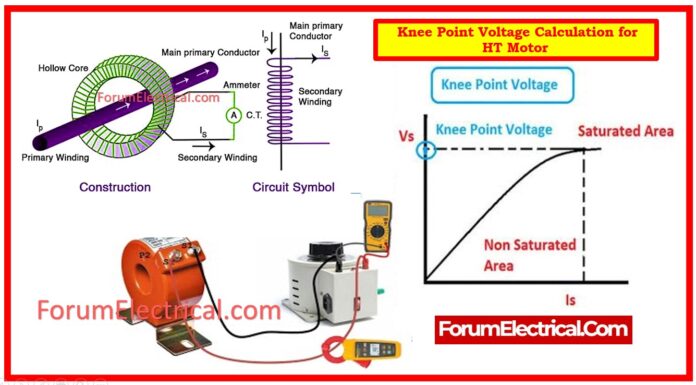To protect High Tension (HT) motors, the knee point voltage of the current transformer (CT) must be calculated accurately.
This excel calculator enables the proper operation of protective relays, especially in differential protection systems.
Calculator
The steps for estimating the knee point voltage for a motor set are outlined below.
Motor and System Specifications
We start by establishing the motor & system parameters required for the calculation.
Motor Requirements
Motor Capacity: The rated power of the HT motor is an important starting point.
System Voltage: The nominal system voltage is also important because it controls the motor’s working conditions.
Current Transformer (CT) Ratings: These comprise the primary & secondary current ratings, as well as the CT ratio, which represents the primary to secondary current ratio.
System Requirements
Starting Current for the HT Motor
HT motors often have a large starting current that can be several times the full load current.
This estimate assumes a starting current of 7.2 times the normal current rating.
However, due to first peaks, it is advisable to double the starting current to provide a more accurate estimate of fault conditions.
Fault Current at CT Secondary
To compute the fault current on the secondary side of the CT, use the following formula:
Ist = Starting Current/ CT Ratio
This fault current reflects the current that the CT need to manage when a fault arises.
Lead Resistance
The resistance of the cable leads connecting the CT & the relay, as well as the relay’s internal resistance, must be taken into consideration.
These resistances contribute to the overall load on the CT secondary circuit. The lead resistance is computed using the distance between the CT & relay, the number of cable runs, & the specific resistance of the cables employed.
RL = [(Ohms per Km) × Distance × Number of Runs]/1000
The total resistance is the sum of the lead, relay, and CT secondary resistances.
Knee Point Voltage (Vk) Calculation
The knee point voltage is an important parameter that determines the voltage at which the CT enters saturation.
It’s calculated with the following formula:
Vk = 2 x [Ist/CT Ratio (RCT+RL)]
Where
Vk – Knee Point Voltage
Ist – Fault Current
RCT – CT Secondary Resistance
RL – Total Lead Resistance
The knee point voltage should be greater than the estimated value to prevent the CT from saturating during fault conditions.
Primary Operated Current (POC) & Relay Settings
The primary operating current (POC) is calculated as a percentage of the rated current, which is commonly set to 30%.
The magnetizing current (Imag) is determined using a 10% relay configuration.
POC = (Relay Setting + Imag x (number of CTs) x CT Ratio
Where
Imag – Magnetizing Current necessary to operate the Relay
POC – Primary Operated Current
The specified knee point voltage for HT motor protection must be greater than the estimated value to ensure proper relay operation during fault conditions.
Proper consideration of starting currents, fault conditions, and secondary circuit resistances is essential for ensuring that the CT operates properly without saturation.
The knee point voltage must be chosen to manage the estimated fault currents while avoiding relay problems.
Click here for more Electrical Calculators







